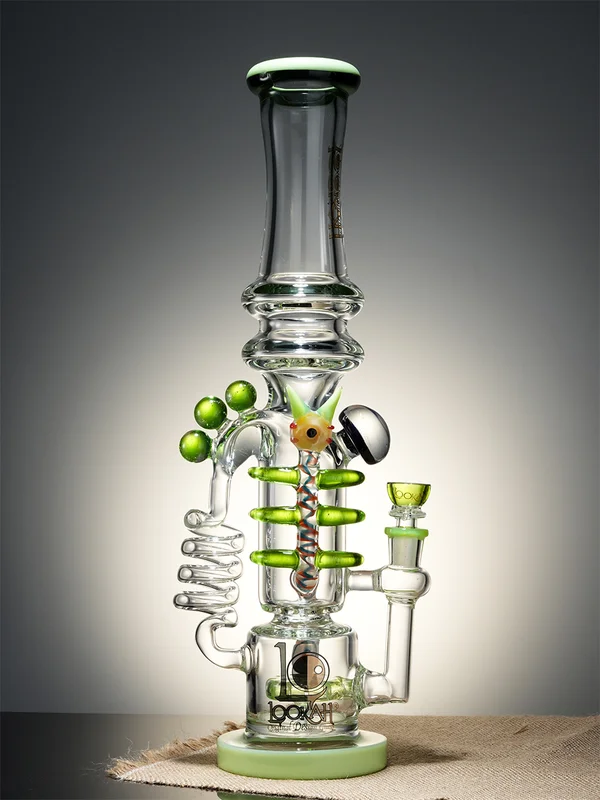Bongs, those iconic water pipes synonymous with cannabis culture, have undergone a remarkable transformation over the centuries. From their ancient origins to the sleek, high-tech designs of today, bongs have evolved in form, function, and cultural significance. This article explores the journey of bongs, comparing their humble beginnings to the innovative devices of the modern era.

Ancient Origins: The Birth of the Bong
The history of bongs stretches back thousands of years, with evidence of their use dating to ancient civilizations. Archaeological findings suggest that water pipes were used in Central Asia as early as 2400 BCE. Scythian tribes, known for their nomadic lifestyle, reportedly used rudimentary bongs made from gold to smoke cannabis and other herbs. These early devices were simple, often consisting of a hollowed-out metal or bone chamber filled with water to cool and filter smoke.
In ancient China, during the Ming Dynasty (1368–1644), bamboo bongs for sale became popular. These pipes were crafted from natural materials, with water chambers designed to enhance the smoking experience by cooling the smoke and reducing harshness. Similarly, in Africa, indigenous tribes used gourds and clay to create water pipes, often incorporating intricate carvings that reflected cultural motifs. These early bongs were functional but limited by the materials and craftsmanship of the time, often bulky and prone to breaking.
The Counterculture Boom: Bongs in the 20th Century
The modern bong as we know it began to take shape in the 1960s and 1970s, fueled by the counterculture movement in the United States. As cannabis use gained popularity, bongs became a symbol of rebellion and self-expression. Glassblowing, an art form revitalized during this period, revolutionized bong design. Artisans like Bob Snodgrass pioneered techniques that allowed for intricate, durable glass bongs with vibrant colors and unique shapes.
These mid-20th-century bongs were a significant leap from their ancient predecessors. They featured improved filtration systems, such as percolators, which diffused smoke through water for a smoother hit. However, they were still relatively simple, often consisting of a single chamber and a basic downstem. Materials like acrylic also emerged as a cheaper alternative to glass, making bongs more accessible but less durable and aesthetically appealing.
The cultural significance of bongs during this era cannot be overstated. They were not just smoking devices but artifacts of a movement, often adorned with psychedelic designs or slogans. Head shops sprang up across the U.S., catering to a growing demand for creative and affordable bongs.
The Modern Era: Innovation and Technology
Fast forward to the 21st century, and bongs have entered a new era of sophistication. Advances in materials, design, and technology have transformed them into high-performance devices that prioritize both function and aesthetics. Today’s bongs are crafted from borosilicate glass, a heat-resistant material that ensures durability and clarity. This allows for intricate designs, from minimalist cylinders to elaborate, multi-chambered works of art.
One of the most significant advancements is the development of complex percolation systems. Modern bongs often feature multiple percolators—such as tree, honeycomb, or showerhead designs—that break smoke into smaller bubbles, increasing filtration and cooling for an exceptionally smooth experience. Some high-end models even incorporate recycler systems, which continuously cycle water and smoke to maximize filtration and flavor.
Technology has also left its mark. Electric bongs, which use electronic heating elements to vaporize cannabis rather than combust it, are gaining traction. These devices offer precise temperature control, reducing harmful byproducts and enhancing flavor profiles. Additionally, modular bongs with interchangeable parts allow users to customize their setups, from ash catchers to specialized bowls.
Aesthetic innovation is another hallmark of modern bongs. Limited-edition pieces, often handcrafted by renowned glassblowers, are treated as collectible art. Collaborations with artists and brands have led to bongs featuring everything from pop culture references to UV-reactive glass that glows under blacklight. Silicone bongs, virtually indestructible and easy to clean, have also emerged as a practical option for on-the-go users.
Cultural Shifts: From Stigma to Mainstream
The evolution of bongs mirrors broader shifts in cannabis culture. Once associated with underground subcultures, bongs are now embraced in mainstream markets as cannabis legalization spreads globally. High-end brands like Grav Labs and Illadelph cater to discerning consumers, offering premium products that rival luxury goods. Bongs are no longer just tools; they’re lifestyle statements, with price tags ranging from $20 for basic models to thousands for custom pieces.
Sustainability is also shaping the industry. Eco-conscious manufacturers are exploring biodegradable materials and recyclable packaging, responding to consumer demand for environmentally friendly products. Meanwhile, the rise of online marketplaces has made bongs more accessible than ever, with countless options available at the click of a button.
Then vs. Now: A Side-by-Side Comparison
- Materials: Ancient bongs used natural materials like bamboo and clay; modern bongs favor borosilicate glass and silicone for durability and aesthetics.
- Design: Early bongs were simple and functional; today’s models boast intricate percolation systems and customizable features.
- Technology: Traditional bongs relied on basic water filtration; modern versions incorporate electric heating and advanced filtration for cleaner, smoother hits.
- Cultural Role: Once niche tools for specific communities, bongs are now mainstream, reflecting cannabis’s growing acceptance.
Looking Ahead
The evolution of bongs is far from over. As cannabis technology advances and cultural attitudes continue to shift, we can expect even more innovation. Smart bongs with app-controlled features, sustainable materials, and integration with other consumption methods like vaping are likely on the horizon. What began as a simple tool for smoking herbs has become a dynamic symbol of creativity, craftsmanship, and cultural change.
Whether you’re a collector, a casual user, or simply curious, the story of the bong is a testament to human ingenuity and the enduring appeal of a smoother, cooler hit.



